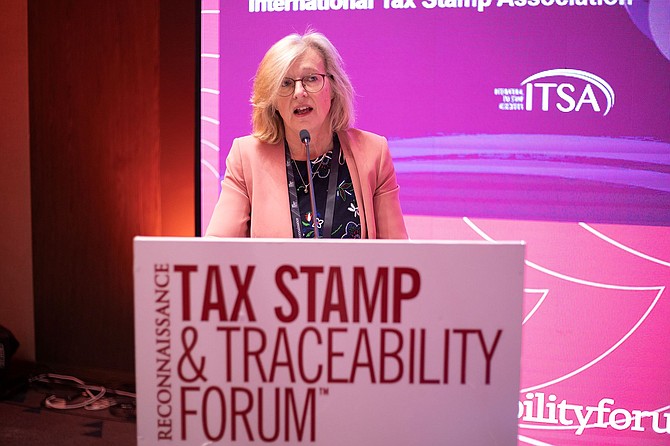
ITSA Counters Claim that Tax Stamp-Based Track and Trace Not Compatible with FCTC Protocol
27 Nov 2023 | ITSA In The News, Press Releases
The International Tax Stamp Association (ITSA) has responded to a claim by economic advisory firm Oxford Economics (OE) that tax stamp-based track and trace systems are not compatible with the WHO FCTC Protocol to Eliminate Illicit Trade in Tobacco Products, while ‘fully digital’ solutions, based on open standards, are.
ITSA argues that the claim, which is part of a report, titled ‘Tobacco Track & Trace Systems Across Africa’, has been formulated from biased arguments favouring solutions preferred by the tobacco industry. This comes as no surprise, given that OE has been funded by the tobacco industry on a number of occasions. Furthermore, ITSA says the report fails to account for a crucial requirement of the Protocol in its various analyses, namely that unique identification markings for track and trace (T&T) must be ‘secure’.
The aim of the OE report, as stated in its executive summary, is to review the progress made by African countries in implementing tobacco T&T systems, as well as assess the effectiveness of these systems and evaluate their compliance with the Protocol. The report then goes on to evaluate the regional T&T regime implemented across the 27 EU member states under the Tobacco Products Directive (TPD), and considers the potential advantages of applying a similar, regional approach within an African context.
In particular, the report assesses the systems currently used to curb illicit tobacco trade in three African countries: Kenya, Tanzania, and Burkina Faso. While Kenya and Tanzania use serialised, high-security tax stamps and automated production monitoring systems, Burkina Faso applies a direct fiscal marking and traceability system based on the tobacco industry’s own Codentify technology. Codentify was originally developed and patented by Philip Morris International, and subsequently sold to a third party.
The EU TPD, meanwhile, requires member states to apply a unique identifier and material-based security features on tobacco products. While member states with tax stamps already in place use their stamps to comply with the security feature requirements, in states without tax stamps manufacturers are required to procure and apply an authentication label on their own. As for the unique identifier for T&T, this is generally applied directly on the product rather than carried on the stamp.
ITSA’s concern with the current TPD system is that it delegates an inordinate amount of responsibility to industry actors, many of whom are among the developers of Philip Morris’ Codentify solution.
OE versus ITSA
Let’s take a closer look at the main findings of the OE report, coupled with ITSA’s counter-arguments and recommendations:
OE: Fully digital T&T solutions, based on open standards, and consisting of a unique code generated during manufacture and applied directly to the product – such as those used in Burkina Faso and across the EU – are the only existing solutions that enable the recording and tracking of the movement of legitimate tobacco products through the supply chain, in accordance with the Protocol.
This is because fully digital solutions are able to meet the Protocol requirement that information pertaining to manufacturing date, location, facility, intended retail market and product description be contained in the unique codes.
Tax-stamp based T&T codes, on the other hand, carry a limited amount of information, given that the stamps are purchased on the date of declaration, rather than on the date of manufacture.
ITSA: ITSA acknowledges that encoding tax stamps with information such as manufacturing date, which is only known at the time of production, would create significant challenges for the supply chain of stamps – and consequently the manufacturing of tobacco products.
However, the fully digital solution recommended in the OE report fails to consider two key requirements of the Protocol: (1) that unique identification markings for track and trace be ‘secure’; (2) that there is a strict minimum of delegation of responsibilities to the tobacco industry.
With regard to the direct marking system in Burkina Faso, for example, there are no elements of security used in the system, which creates two major gaps:
(1) no means for authenticating a product, given that it is nearly impossible for a consumer or government inspector to distinguish between a genuine product and a counterfeit; (2) the possibility for shady actors to clone the identification codes used for T&T as many times as they want.
As for the EU TPD, ITSA and NGOs such as Smoke Free Partnership (SFP) already raised concerns before its implementation, in 2019, that the tobacco industry, and not member states, was being given too much control over virtually all aspects of the T&T system. But these concerns went unheard.
Specifically, the industry is able to select, and contract directly with, third-party technology providers of T&T. Although these third parties must be approved by the European Commission, some of them have long-standing, documented relationships with the tobacco industry. In addition, TPD legislation potentially opens the door for the industry to apply its own security elements on unit packs of tobacco products, given that only one out of the five overt and covert elements required on the packs needs to be supplied by an independent third party.
Given the aforementioned weaknesses of the fully digital solution proposed in the OE report, ITSA recommends leveraging the high security elements of a tax stamp, combined with a unique ID that is carried and secured by the stamp. This ID enables traceability of virtually all data fields required by the FCTC Protocol (Article 8.4) via a link to a national T&T database. An additional marking can be printed directly on the packaging to capture information only known at the time of production (eg. date and location of manufacture). More details on this solution are available from the FCTC blueprint document issued by ITSA in 2020 1.
ITSA’s proposed model offers a number of key advantages, including:
- A high degree of protection against fraud, thanks to the use of tax stamps with multiple authentication elements that provide immediate visibility.
- A high degree of independence from the tobacco industry, given that delegation of responsibilities to the industry or any subcontracted party is kept to the strict minimum.
From a security perspective, this model is also in line with a call by organisations such as ISO to strengthen the importance of the link between digital and physical authentication features, especially in light of the threat from artificial intelligence. In fact the chair of the ISO working group responsible for standards relating to fraud countermeasures is seeking to develop a standard dedicated to this matter.
OE: There is no interoperability between tax stamp-based T&T systems, meaning that any codes affixed to packs are meaningless to other national authorities. The Protocol, however, calls for parties to implement a global T&T regime, comprising national or regional T&T systems and a global information-sharing focal point (GSP).
ITSA: The GSP has been designed to have minimum impact on systems adopted by the parties and to be
technologically neutral. It consists of a sort of secure mailbox system, allowing authorities to communicate around the unique identifiers affixed on tobacco products. Considering the tax stamp- based track and trace systems provided by its 28 members, ITSA anticipates that, once the GSP is established, these systems will all be able to interface with it, enabling global interoperability and cross-border collaboration among law enforcement agencies.
OE: Tax stamps are too expensive.
ITSA: A number of recent articles in Tax Stamp & Traceability News™ provide examples of countries in Africa and other regions that have reported increased revenues following the implementation of tax stamp and traceability programmes. What’s more, these increases largely surpass the operational and implementation costs of the programmes, thereby demonstrating that tax stamps are not only an effective tax administration tool but also a financially sustainable one.
No such evidence is available with regard to the EU TPD, however. Despite its complexity and cost, and after more than four years of implementation, no evidence has yet been reported from industry-independent sources to support its effectiveness. On the contrary, research conducted by KPMG and commissioned by the tobacco industry indicates that the level of illicit trade in the EU region has increased since 2019.
The same goes for Burkino Faso, a crisis-ridden country that is among the 10 poorest in the world, and that implemented the Codentify system thanks to the financial support of the tobacco industry. Again, no evidence has been reported on the effectiveness of this system to fight illicit trade. In fact, according to a March 2023 report by OCCRP, it seems that packs of cigarettes produced in Burkina Faso have been seized bearing no markings and are potentially being used for terrorism financing.
OE: Africa’s Regional Economic Communities (RECs) should consider adopting a common interoperable T&T solution to enable cross-border sharing of data and close cooperation to eradicate illicit trade. The EU’s digital T&T system provides a base model for Africa’s RECs to follow.
ITSA: When it comes to advising governments on the track and trace solution to be implemented for tobacco control, it is important to take into account how the solution fits with the economic and technology environment of each country, as this greatly varies between regions. Replicating the EU TPD approach in Africa would present a unique set of challenges and complexities, given the significant differences between the two regions from an economic, fiscal and supply chain perspective.
The EU TPD system requires comprehensive capture of tobacco product movements across all stages of the supply chain, from manufacturing to warehousing, wholesale, and up to retail. This is clearly impractical in low-income countries with limited infrastructure, poor tax compliance, high levels of informality, and a highly fragmented supply chain. Given that a system is as weak as its weakest component, as soon as a few actors fail to comply, the whole promise of the TPD system to detect illicit trade products in the supply chain simply falls apart.
Implementing a TPD-like system incurs substantial costs, ranging from technology investments to regulatory enforcement efforts needed to compensate for the lack of tax stamps and authentication mechanisms available to the general public and the authorities. For resource- constrained governments, the financial burden of such implementation can be prohibitive. Even smaller tobacco manufacturers may find it challenging to make the required investments, potentially pressuring the market towards consolidation around large multinationals, stifling competition and local development.
What sets tax stamp-based track and trace programmes apart from the EU TPD system is their ability to deliver benefits without imposing entry barriers and operational burden on the entire distribution network. Unlike complex tracking and tracing systems that require significant investments in technology and infrastructure, tax stamps are a relatively straightforward and cost-effective solution.
This simplicity not only ensures that implementation costs are manageable for governments but also eases the compliance burden on industry stakeholders, particularly small and medium-sized enterprises. In this regard, tax stamps optimise both regulatory effectiveness and economic viability, making them the preferred choice for many countries seeking to regulate the tobacco industry efficiently, especially on the African continent.
In reality, says ITSA, modern tax stamps combine highly sophisticated authentication and traceability technology, offering untarnished independence from the tobacco industry, providing immediate visibility of illicit products to all stakeholders, and optimising market monitoring and law enforcement efforts. Most importantly, they have a proven track record of enabling revenue mobilisation and reducing illicit trade, with spectacular results especially in low- and middle- income countries. What’s more, virtually all tax stamp programmes are able to implement interfaces with the GSP of the Protocol.
ITSA cautions revenue authorities to exercise vigilance in the face of the tobacco industry’s efforts to undermine tax stamp programmes while advocating for ‘fully digital’ systems that grant undue influence to multinational tobacco manufacturers.
Regardless of a nation’s economic environment and infrastructure, hard evidence points to tax stamp programmes as most effective in bolstering revenue collection and reducing illicit trade.
1 – https://tax-stamps.org/proposal-for-an-fctc-protocol-compliant-tobacco-control-system-blue-print/







